The Wave Mill unit is a large pontoon with embedded power supply. The Wave Mill works quietly and can be moored in the close to shore waters or deployed as a pole-framed structure.
The Wave Mill’s output depends on the input from the waves and WM dimensions.
Our
Wave Mill Calculator can help you to estimate output.
Read more
about the Wave Mill concept and design
The Wave Mill breakwaters for the coastal protection, beach accretion and marinas
Conventional floating breakwaters work by dissipating and reflecting part of the wave energy. WM breakwater also dissipating and reflecting part of the wave energy but unlike conventional floating breakwaters, Wave Mill also converts significant part of the wave energy into electricity.
Read about the Wave Mill at
The Switch Report
The Wave Mill unit attenuates waves and can be used as a breakwater for the coastal protection, beach accretion and marinas.
Conventional floating breakwaters work by dissipating and reflecting part of the wave energy. WM breakwater also dissipating and reflecting part of the wave energy but unlike conventional floating breakwaters, Wave Mill also converts significant part of the wave energy into electricity.
Positive points of floating breakwaters
Floating breakwaters represent an alternative solution to protect an area from wave attack, compared to conventional fixed breakwaters. It can be effective in coastal areas with mild wave environment conditions. Therefore, they have been increasingly used aiming at protecting small craft harbours or marinas or, less frequently, the shoreline, aiming at erosion control. Some of the conditions that favour floating breakwaters are:
Poor foundation: Floating breakwaters might be a proper solution where poor foundations possibilities prohibit the application of bottom supported breakwaters.
Deep water: In water depths in excess of 6 m, bottom connected breakwaters are often more expensive than floating breakwaters.
Water quality: Floating breakwaters present a minimum interference with water circulation and fish migration.
Ice problems: Floating breakwaters can be removed and towed to protected areas if ice formation is a problem. They may be suitable for areas where summer anchorage or moorage is required.
Visual impact: Floating breakwaters have a low profile and present a minimum intrusion on the horizon, particularly for areas with high tide ranges.
Breakwater layout: Floating breakwaters can usually be rearranged into a new layout with minimum effort.
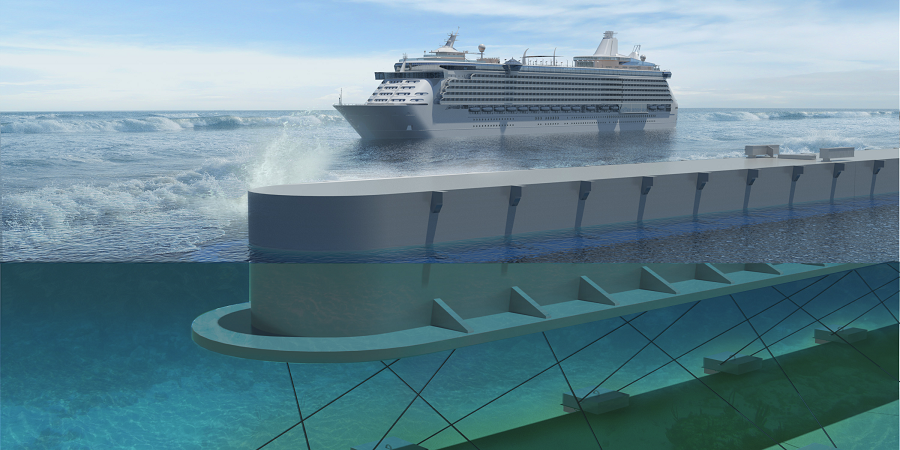
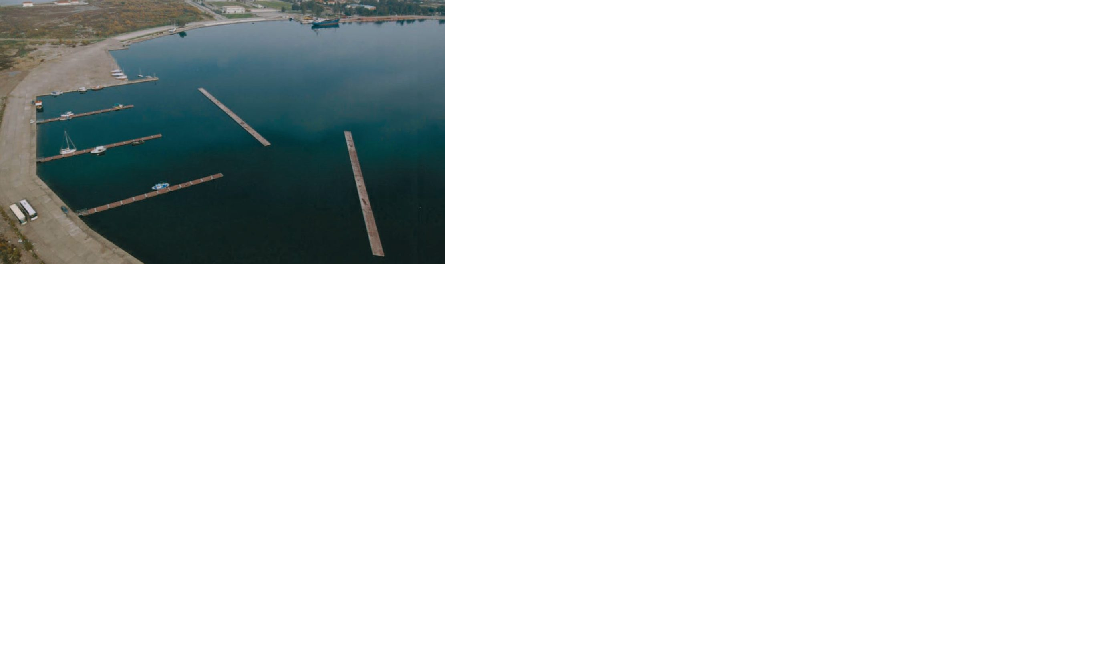
Background
Nearshore detached breakwaters are often considered an option for beach erosion control as part of coastal defence schemes. The dominant effect of a detached breakwater is to reduce the incident wave energy on a section of the coast and thereby reduce the sediment transport capacity in the sheltered region. In this way, detached breakwaters promote the accumulation of sediments, and hence shoreline accretion, in their lee. Detached breakwaters have been used extensively in Japan, the US, Singapore and the Mediterranean.
Effect of detached breakwaters
The effect of a detached breakwater is to reduce the incident wave energy on a section of the coast in its lee. This reduction of wave energy in the lee of a breakwater scheme induces complex flow circulation patterns due to gradients in the wave set-up, wavedriven longshore flow and tidal flows, resulting in complex sediment transport patterns. In a meso- or macro-tidal environment, the littoral zone2 is continually changing as the water level changes with the tide. Furthermore, tidal currents also interact with wavedriven currents, leading to more complex flow and sediment transport patterns. These complex sediment transport patterns produce morphological changes in the vicinity of the breakwater. These changes include:
a) sediment deposition in the lee of the breakwater;
b) erosion in the breakwater bays; and
c) scour near the breakwater heads.
Thus, understanding the likely incident wave and water level conditions, how the breakwater will influence the incident wave energy distribution and tidal flows on the beach, and the beach’s response to the new conditions are the three key elements for selecting an appropriate geometrical layout of a breakwater scheme.
The Wave Mill - nearshore breakwater
We propose to use the Wave Mill unit as a nearshore breakwater.
Wave Mill unit is a long pontoon. Two Wave Mill units moored as an angle shape generate a power.
After some time, breakwater creates tombolo (salient). After that line of the Wave Mill units can be moved and moored against erosion area. After some time, breakwater creates salient and shoreline will be relatively straight.
The overall power output depends on the number of the deployed Wave Mill units and input from the waves.
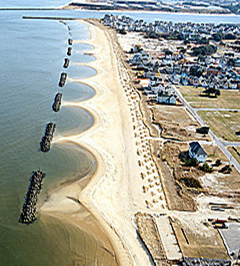
Conventional detached breakwater
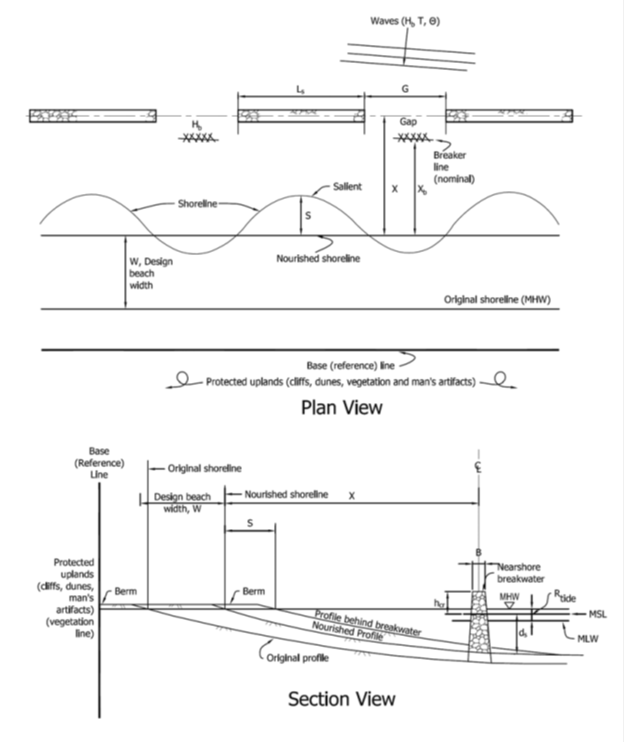
Wave Mill nearshore breakwater
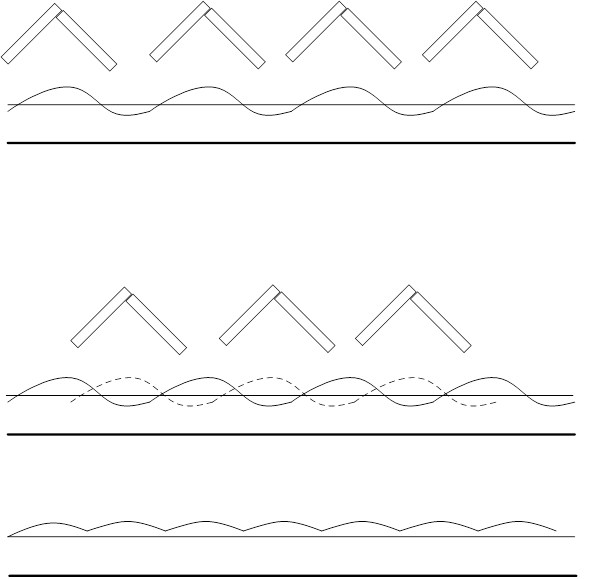
The Wave Mill can be used offshore as a support facility or floating foundation for the offshore wind or oil rigs.
The Wave Mill unit with dimensions 200mX200m provides 5MW power supply from the 3m waves.
The average power supply for the modern oil-rig is 5MW.
In the offshore wind, the cost of foundation is about 35%.
The Wave Mill as a floating foundation increases overall generating capacity and reduces payback period.
200mX200m WM unit provides stiff floating foundation with embedded 5MW power supply.
The Wave Mill can be configured as a mobile offshore base.
To be able to compare output from the different wave parameters and Wave Mill dimensions you can open multimple calculator pages.
Open Wave Mill Calculator.